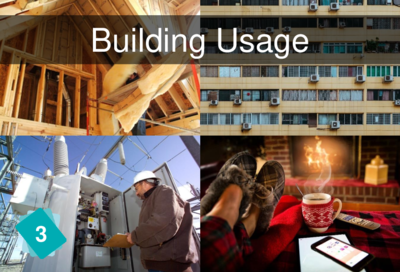En-en adult card 3 building: Difference between revisions
Jump to navigation
Jump to search
No edit summary |
(First pass on the page) |
||
| Line 7: | Line 7: | ||
== Explanation == | == Explanation == | ||
We consider here buildings usage, not their construction (which is part of the industrial sector). Heating, air-conditioning, lighting, electronics, etc. The big topic in our latitudes is the thermal insulation of buildings. As far as new construction is concerned, it is important to build well insulated buildings. But the stakes are limited because the standards for new buildings are much stricter than in the past and only a small part (1%) of the buildings already built are constructed each year. The challenge is therefore much more in the thermal renovation of buildings. | |||
== | == Other possible links == | ||
=== | === Consequences === | ||
*[[ | *[[En-en adult card 26 river flooding|River flooding]] Soil artificialisation is also responsible for flooding because the soil is no longer able to absorb rain water. | ||
* [[ | * [[En-en adult card 10 aerosols|Aerosols]] Buildings emit few aerosols directly. The only significant emissions are chimney fires. In Chamonix, 85% of the fine particles present in the atmosphere come from wood heating <ref>[https://www.lemonde.fr/pollution/article/2016/12/08/dans-la-vallee-de-chamonix-le-chauffage-au-bois-est-le-principal-coupable-de-la-pollution_5045636_1652666.html Le monde, ''Dans la vallée de Chamonix, le chauffage au bois est le principal coupable de la pollution'']</ref>. | ||
== Sources == | == Sources == | ||
Revision as of 12:47, 2 February 2021
Card #3: Building
| Causes | Consequences | |

|
The building sector (housing and commercial use) uses fossil fuels and electricity.
It accounts for 20% of greenhouse gas (GHG) emissions.
Explanation
We consider here buildings usage, not their construction (which is part of the industrial sector). Heating, air-conditioning, lighting, electronics, etc. The big topic in our latitudes is the thermal insulation of buildings. As far as new construction is concerned, it is important to build well insulated buildings. But the stakes are limited because the standards for new buildings are much stricter than in the past and only a small part (1%) of the buildings already built are constructed each year. The challenge is therefore much more in the thermal renovation of buildings.
Other possible links
Consequences
- River flooding Soil artificialisation is also responsible for flooding because the soil is no longer able to absorb rain water.
- Aerosols Buildings emit few aerosols directly. The only significant emissions are chimney fires. In Chamonix, 85% of the fine particles present in the atmosphere come from wood heating [1].